Aizoaceae
| Aizoaceae | |
|---|---|
 | |
| Sesuvium portulacastrum | |
| Scientific classification | |
| Kingdom: | Plantae |
| Clade: | Angiosperms |
| Clade: | Eudicots |
| Order: | Caryophyllales |
| Family: | Aizoaceae Martynov |
| Genera | |
|
See text | |
Aizoaceae or Ficoidaceae (the fig-marigold family or ice plant family) is a family of dicotyledonous flowering plants containing 135 genera and about 1900 species. They are commonly known as stone plants, carpet weeds or vygies. Species that resemble stones or pebbles are sometimes called mesembs. Several species are known as "ice plants" because of the glistening globular bladder cells covering their stems, fruit and leaves.
Description
The family is widely recognised by taxonomists, although once it went by the botanical name "Ficoideae", now disallowed. The APG II system of 2003 (unchanged from the APG system of 1998) also recognises the family, and assigns it to the order Caryophyllales in the clade core eudicots. The APG II system also classes the former families Mesembryanthemaceae Fenzl, Sesuviaceae Horan. and Tetragoniaceae Link under the family Aizoaceae.
Most species (96%, 1782 species in 132 genera) in this family are endemic to arid or semiarid parts of southern Africa,[1] but a few are from Australia and the Central Pacific. Most of these species are succulents and belong to the subfamilies Mesembryanthemoideae and Ruschioideae and are loosely termed mesems or mesembs.
Most fig-marigolds are herbaceous, rarely somewhat woody, with stems growing either erect or prostrate. Leaves are simple, opposite or alternate, and more or less succulent with entire (or rarely toothed) margins. Flowers are perfect in most species (but unisexual in some), actinomorphic, and appear singularly or in few-flowered cymes developing from the leaf axils. Sepals are typically five (3-8) and more or less connate (fused) below. True petals are absent. However, some species have numerous linear petals derived from staminodes. The fruit is a capsule with one to numerous seeds per cell.
A few species (especially Carpobrotus edulis, commonly called ice plant) have been widely introduced and become invasive.
They are called ice plant because "they have bladder-like hairs on the leaf surface that reflect and refract light in a manner to make it appear that they sparkle like ice crystals."[2]
Uses
Several Aizoaceae are edible, including:
- Carpobrotus edulis and Mesembryanthemum crystallinum have edible leaves, and are both commonly called ice plant.
- A species known as New Zealand spinach (Tetragonia tetragonioides) is grown as a garden plant in somewhat dry climates and used as an alternative to spinach in upscale salads.
Carpobrotus edulis was introduced to California to stabilize soil along railroad tracks.
Ice plant thrives in southern California. People surround their property with it believing it will act as a firewall to protect against wildfires; ice plant contains so much water, it does not burn if carefully maintained.
Genera
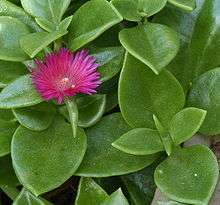
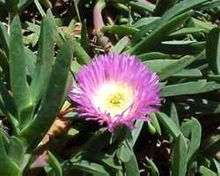
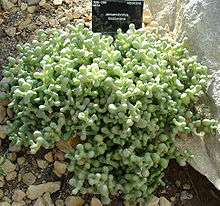
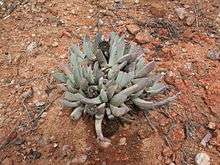
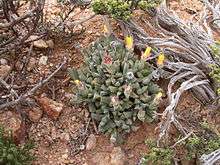

Subfamily Aizooideae
- Acrosanthes Eckl. & Zeyh.
- Aizoanthemum Dinter ex Friedrich
- Aizoon L.
- Galenia L.
- Gunniopsis Pax
- Plinthus Fenzl
- Tetragonia L.[3]
Subfamily Mesembryanthemoideae
|
Subfamily Ruschioideae
|
|
|
Subfamily Sesuvioideae
- Cypselea Turpin
- Sesuvium L.
- Trianthema L.
- Tribulocarpus S.Moore
- Zaleya Burm.f.[8]
Incertae sedis
- Corbichonia
- Gisekia
- Herreanthus
- Limeum
- Ophthalmophyllum
- Saphesia
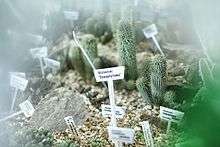
Footnotes
- ↑ Chesselet, P., Smith, G.F., Burgoyne, P.M., Klak, C., Hammer, S.A., Hartmann, H.E.K., Kurzweil, H., van Jaarsveld, E.J., van Wyk, B-E. & Leistner, O.A (2000). "Seed Plants of Southern Africa". Strelitzia. 10: 360–410.
- ↑ Smith, Curtis. "Ice plant". Southwest Yard & Garden. New Mexico State University. Retrieved 25 April 2014.
- ↑ "GRIN Genera of Aizoaceae subfam. Aizooideae". Germplasm Resources Information Network. Retrieved 2011-03-04.
- ↑ "GRIN Genera of Aizoaceae subfam. Mesembryanthemoideae". Germplasm Resources Information Network. Retrieved 2011-03-04.
- ↑ "GRIN Genera of Aizoaceae tribe Apatesieae". Germplasm Resources Information Network. Retrieved 2011-03-04.
- ↑ "GRIN Genera of Aizoaceae tribe Dorotheantheae". Germplasm Resources Information Network. Retrieved 2011-03-04.
- ↑ "GRIN Genera of Aizoaceae tribe Ruschiae". Germplasm Resources Information Network. Retrieved 2011-03-04.
- ↑ "GRIN Genera of Aizoaceae subfam. Sesuvioideae". Germplasm Resources Information Network. Retrieved 2011-03-04.
References
- Bittrich V. H. E. K. Hartmann (1988). "The Aizoaceae—a new approach". Bot. J. Linn. Soc. 97 (3): 239–254. doi:10.1111/j.1095-8339.1988.tb01581.x.
- Cornelia Klak; Angeline Khunou; Gail Reeves; Terry Hedderson (2003). "A phylogenetic hypothesis for the Aizoaceae (Caryophyllales) based on four plastid DNA regions". Amer. J. Bot. 90 (10): 1433–1445. doi:10.3732/ajb.90.10.1433.
External links
| Wikimedia Commons has media related to Aizoaceae. |
- Aizoaceae in L. Watson and M.J. Dallwitz (1992 onwards). The families of flowering plants
- NCBI Taxonomy Browser
- P. Chesselet (2004 onwards). Interactive Mesembs2
- Plants of southern Africa (2005 onwards). SANBI
- Aizoaceae of South Africa
- Family Aizoaceae Flowers in Israel